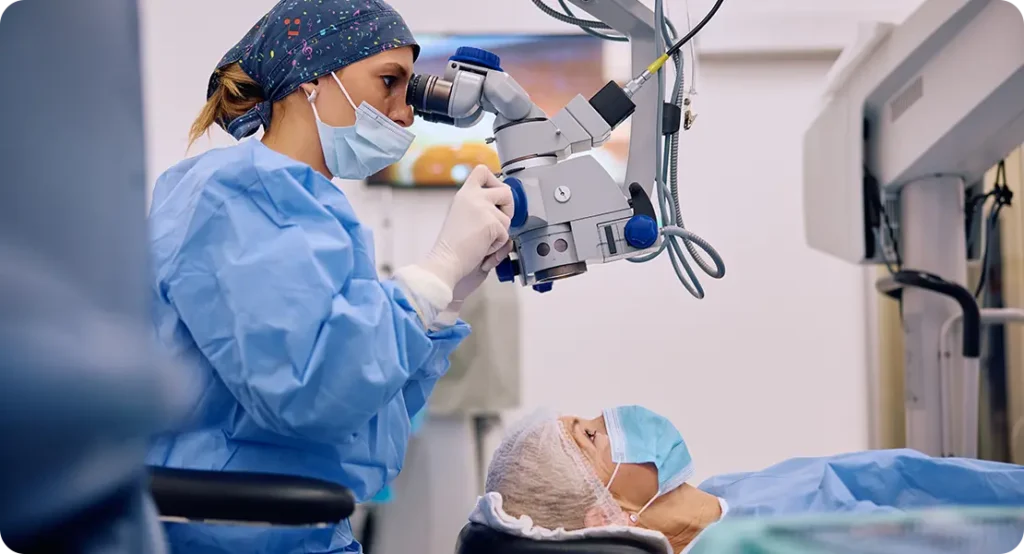If you’re dealing with blurry vision, glare, or trouble seeing clearly at night, you might have astigmatism, cataracts, or even both. These two eye conditions often show up together, especially as you get older. But here’s the good news: cataract surgery doesn’t just fix cloudy vision—it can also help correct astigmatism. Let’s break it down.
What Exactly is Astigmatism?
Astigmatism happens when the cornea or lens in your eye isn’t perfectly round but more oval-shaped. This uneven shape bends light in different directions, making vision blurry or distorted. It can be something you’re born with or develop over time due to changes in your eyes, injury, or even previous eye surgery.
If you have astigmatism, you might notice:
- Blurry or distorted vision – When the cornea isn’t perfectly shaped, light doesn’t focus evenly on the retina, causing vision to be smeared or doubled. This effect can make reading difficult and create challenges in recognising faces at a distance. Everyday activities such as watching TV or working on a computer may feel more straining due to the inconsistent clarity of vision.
- Eye strain or discomfort – Since your eyes work harder to bring things into focus, they can easily become fatigued. You may experience soreness or a feeling of pressure around your eyes, especially after prolonged periods of reading, driving, or screen use. This can lead to a sensation of tiredness even when you haven’t physically exerted yourself.
- Frequent headaches – Because astigmatism makes it harder for your eyes to process light correctly, the constant effort to adjust can result in headaches. These headaches are often felt around the forehead or temples and tend to intensify as the day progresses. If left unaddressed, they can interfere with daily tasks and lower productivity levels.
- Difficulty seeing clearly at night – Low-light environments worsen the effects of astigmatism. You might notice increased halos or glare around lights, making night driving particularly challenging. The distorted perception of streetlights and oncoming headlights can reduce confidence on the road and increase the risk of accidents.
- The need to squint to focus on objects – Squinting is a natural response to blurry vision as it temporarily improves focus by slightly adjusting the way light enters your eyes. However, relying on squinting frequently can lead to eye fatigue and deepen the problem rather than offering a long-term solution.

What About Cataracts?
Cataracts form when the natural lens in your eye gets cloudy, which happens gradually as you age. They can also be caused by genetics, diabetes, prolonged sun exposure, smoking, or previous eye injuries.
Typical signs of cataracts include:
- Blurred or cloudy vision – A cataract scatters light as it passes through the eye, creating a foggy or dull effect. This can make details harder to distinguish and reduce the sharpness of objects. As the cataract worsens, even basic tasks like reading or recognising facial expressions may become frustrating.
- Sensitivity to light and glare – Bright lights may start to feel overwhelming, and glare from lamps or sunlight can cause discomfort. This issue is particularly noticeable when transitioning from a dimly lit space to a brighter one, leading to a temporary sensation of being dazzled.
- Difficulty seeing in dim lighting – Cataracts affect the way your eyes process light, making low-light environments harder to navigate. You may find it increasingly difficult to see well in restaurants, cinemas, or while driving at dusk, making activities that once felt effortless much more challenging.
- Colours looking dull or yellowed – As cataracts develop, they filter out blue light, causing colours to appear faded or tinged with a yellowish hue. This can affect everyday perception, making it difficult to distinguish between shades and reducing the vibrancy of the world around you.
- Needing frequent prescription changes for glasses or contacts – If you find yourself updating your prescription more often than usual, cataracts might be to blame. As they progress, they alter the way your eyes focus, requiring stronger lenses to compensate for the worsening vision.
How Are Astigmatism and Cataracts Connected?
It’s pretty common for people with cataracts to also have astigmatism. Sometimes, cataracts can even make astigmatism worse by changing the shape of the lens inside your eye. The more your cataracts progress, the harder it becomes to see clearly, making everyday tasks like reading or driving more challenging.
When cataracts develop, they cause the natural lens to become denser and less flexible. This shift in the structure of the eye can lead to irregularities in how light is refracted, effectively exaggerating the effects of astigmatism. As the lens thickens and loses its transparency, light struggles to pass through smoothly, further blurring vision. The combination of cataracts and astigmatism makes it difficult for the eyes to focus properly, leading to increasing visual disturbances over time.

Additionally, as cataracts mature, they can cause the lens to shift slightly within the eye, altering its overall shape. This movement can increase the severity of pre-existing astigmatism or even cause astigmatism to develop in individuals who previously had no refractive issues. Because cataracts grow gradually, many people don’t realise how much their vision has deteriorated until they struggle with simple tasks like recognising faces, reading fine print, or seeing clearly in dim lighting.
Since cataracts and astigmatism both contribute to blurry vision, people experiencing both conditions may notice a rapid decline in their ability to perform everyday activities. This can be particularly frustrating, as glasses alone may no longer provide the clarity needed. Fortunately, cataract surgery presents an excellent opportunity to not only remove the clouded lens but also correct astigmatism simultaneously, offering a clearer and more stable vision outcome.
How Cataract Surgery Can Fix Astigmatism
Cataract surgery involves removing the cloudy lens and replacing it with a clear artificial lens (called an intraocular lens or IOL). In the past, standard IOLs only corrected blurry vision caused by cataracts but didn’t do much for astigmatism. Luckily, newer techniques allow for both issues to be addressed at the same time.

1. Toric Intraocular Lenses (Toric IOLs)
If you have astigmatism, your best bet is a toric IOL. Unlike regular lenses, toric IOLs are specially designed to counteract the uneven curvature of your cornea, giving you sharper vision without needing glasses or contacts for distance vision.
Toric IOLs are custom-designed to align with the specific axis of your astigmatism. This ensures that light entering your eye is properly focused, providing clearer and more stable vision. The placement of a toric IOL during cataract surgery requires precise measurement and alignment, which is carefully done by your surgeon to maximise its effectiveness.
These lenses not only improve visual sharpness but also enhance contrast sensitivity, reducing issues like glare and halos that often accompany both cataracts and astigmatism. Many patients who opt for toric IOLs find that their need for corrective eyewear is significantly reduced, especially for distance vision.
Another advantage of toric IOLs is their durability. Unlike glasses or contact lenses that require frequent updates, toric lenses are a permanent solution. They provide long-term benefits, allowing patients to enjoy clearer vision without ongoing adjustments or replacements.
2. Limbal Relaxing Incisions (LRI) and Astigmatic Keratotomy (AK)
Another option is making tiny incisions in the outer part of your cornea during surgery. This technique, known as limbal relaxing incisions (LRI) or astigmatic keratotomy (AK), helps reshape your cornea to improve vision. While not as precise as toric IOLs, it works well for mild astigmatism.
These incisions work by relaxing the corneal curvature, reducing its irregular shape so that light can focus more evenly on the retina. The healing process gradually refines the corneal shape, leading to improved visual clarity. Many patients notice a difference in their vision within a few days of the procedure.
While LRI and AK are effective for lower degrees of astigmatism, they may not fully correct higher levels of refractive error. However, they can be combined with other techniques, such as toric IOLs, for a more comprehensive approach.
3. Laser-Assisted Cataract Surgery
If you want an alternative approach, laser-assisted cataract surgery is a great option. A femtosecond laser can create corneal incisions and assist in correcting mild to moderate astigmatism while breaking up the cataract for removal. Many patients experience improved vision and a smoother recovery with this technique.
Laser-assisted surgery allows for a more automated and consistent incision-making process, which can be beneficial in certain cases. While it doesn’t necessarily provide superior results compared to traditional manual techniques, it offers another method for addressing cataracts and astigmatism simultaneously. Some patients prefer this approach due to its technological advancements and the perception of a more controlled procedure.
Additionally, the customisation options with laser technology can assist in achieving a better alignment of the IOL, which is crucial for astigmatism correction. Ensuring that the lens is positioned accurately helps contribute to a more stable visual outcome and reduces the likelihood of residual refractive errors after surgery.
By choosing laser-assisted cataract surgery, patients may benefit from a procedure that requires less manual handling of the eye’s structures, potentially reducing risks such as corneal swelling. While both laser-assisted and traditional methods have their advantages, the decision ultimately depends on individual eye health, cataract surgeon preference, and specific vision correction needs.
Why Fix Astigmatism During Cataract Surgery?
Getting astigmatism corrected at the same time as cataract surgery can make a huge difference. Here’s why:

- Less Dependence on Glasses – Many people find they don’t need glasses for distance vision after surgery. Having reduced reliance on glasses means greater freedom in daily activities, whether it’s driving, watching TV, or simply enjoying outdoor scenery. This benefit is especially noticeable for those who have relied on prescription lenses for years, as the improvement in vision post-surgery can feel life-changing. Additionally, fewer visits to the optician for updated prescriptions can save both time and money in the long run. Another major advantage is that reducing the need for glasses helps in social and professional settings. Many individuals feel more confident when they don’t have to wear glasses all the time, especially for events where appearance matters. While reading glasses may still be needed for close-up work, the ability to see clearly at a distance without external lenses enhances overall visual convenience. This reduction in dependence on glasses also extends to physical activities. Sports, exercise, and outdoor hobbies become more enjoyable without the hassle of glasses slipping or fogging up. Whether it’s playing golf, hiking, or simply going for a jog, clear unaided vision makes these experiences far more comfortable and practical.
- Sharper, Clearer Vision – No more blurriness, double vision, or distorted images. One of the biggest frustrations with both astigmatism and cataracts is the constant struggle to focus. After surgery, patients often describe the sensation as seeing the world in high definition for the first time. Everything appears crisper, making tasks like reading road signs or recognising faces from a distance much easier. The improved clarity also makes a difference in fine details. Text on screens, labels on products, and even facial expressions become easier to perceive, reducing strain on the eyes. For professionals who rely on visual precision, such as artists, engineers, or those who work with computers, this sharpness can make a huge impact on productivity and comfort. Additionally, clearer vision reduces visual confusion. Many individuals with untreated astigmatism experience “ghosting” or overlapping images. Post-surgery, these distortions are eliminated, leading to a more relaxed and natural viewing experience without the frustration of constantly refocusing.
- Better Contrast and Reduced Glare – Night driving and reading become much easier. Cataracts and astigmatism both contribute to excessive glare, which can make bright lights feel blinding. After surgery, many patients find that their ability to handle varying lighting conditions improves dramatically. This makes transitioning between indoor and outdoor lighting smoother and reduces the discomfort caused by harsh artificial lights. Night vision is another area where improvement is highly noticeable. Before surgery, headlights from oncoming cars might create starburst effects, making it difficult to judge distances and road conditions. After correction, these distractions are minimised, making night driving safer and less stressful. Better contrast sensitivity also means colours appear more vivid. Shades that once seemed muted due to cataracts regain their richness, making everything from reading to watching TV a more visually engaging experience. This heightened perception of detail contributes to an overall improved quality of life.
- Improved Quality of Life – Seeing clearly makes daily tasks and activities way more enjoyable. The ability to navigate the world with ease and confidence is something many people take for granted until their vision starts to decline. Post-surgery, everyday tasks like cooking, shopping, and even recognising loved ones become effortless again, restoring independence. Better vision also encourages more social engagement. Many individuals with poor eyesight withdraw from activities they once enjoyed due to the difficulty of seeing clearly. With improved vision, reconnecting with hobbies, meeting friends, and enjoying outings becomes much easier. Finally, the mental and emotional benefits cannot be overlooked. Struggling with poor vision can be frustrating and even isolating. Restoring clear sight brings a renewed sense of enthusiasm for life, reducing stress and boosting overall well-being.
Final Thoughts
If you have both astigmatism and cataracts, there’s no need to worry. Cataract surgery has come a long way, and with the right options—whether it’s toric lenses, corneal incisions, or laser-assisted techniques—you can achieve clear, sharp vision. If you’re noticing changes in your eyesight, it’s worth speaking to an eye specialist to find the best solution for you.
Concerned about cataracts?
You can contact us at the London Cataract Centre to arrange a consultation with one of our experienced cataract surgeons. We’re here to help you explore your options and restore your vision with the latest advancements in cataract treatment


